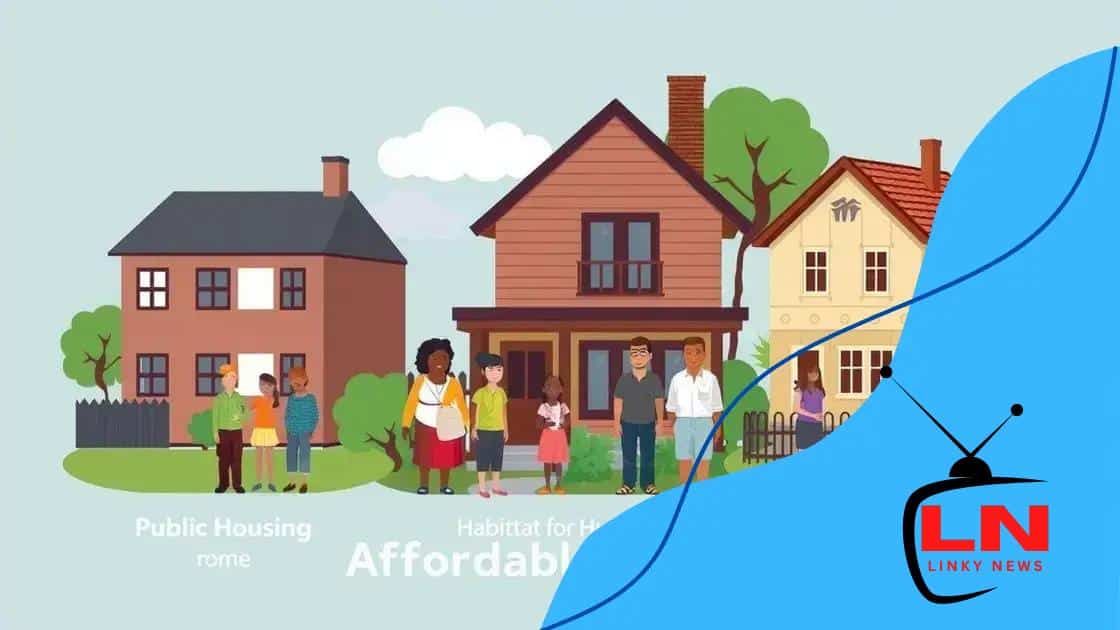Affordable housing programs: Unlocking your dream home

Affordable housing programs provide essential low-cost housing options, improving economic stability, social inclusion, and community engagement for families in need of secure living environments.
Affordable housing programs are designed to assist those seeking safe and low-cost housing options. Have you ever wondered what opportunities exist to help you secure a home that fits your budget? This article dives into the various programs available and how they can support your housing journey.
Understanding the landscape of affordable housing programs
Understanding the landscape of affordable housing programs is essential for anyone seeking secure and budget-friendly housing options. These programs vary widely and can be tailored to meet different community needs.
Government Programs
Many governments offer assistance to help individuals find affordable housing. Federal, state, and local programs may include:
- Section 8 Housing Choice Voucher Program
- Low-Income Housing Tax Credit (LIHTC)
- Public Housing Authorities
- Usda Rural Development Programs
Each program has unique guidelines, but they all aim to provide safe, decent, and affordable living conditions. Local initiatives often complement these government efforts by focusing on specific community needs.
Nonprofit Organizations
Numerous nonprofit organizations also play a vital role in providing affordable housing. These organizations often rely on donations and grants to support their efforts. Some prominent groups include Habitat for Humanity and the National Low Income Housing Coalition. They work towards:
- Constructing homes for those in need
- Securing housing subsidies
- Advocating for policy changes
Through these initiatives, nonprofits help bridge the gap between low-income families and suitable housing. The methods used can vary, but the commitment to affordability remains constant across all programs.
The landscape of affordable housing continues to change, motivated by shifting economic conditions and demographic trends. It’s beneficial for prospective homeowners or renters to actively research the options available within their local area.
With the right knowledge, individuals can take advantage of the opportunities presented by these programs and envision a brighter future for themselves and their families.
How to qualify for affordable housing assistance
Knowing how to qualify for affordable housing assistance can open doors to better living situations for many families. The process might seem daunting, but understanding the requirements simplifies it.
Eligibility Criteria
Each program has specific eligibility criteria, mainly focused on income, family size, and residency status. Common requirements include:
- Income limits based on your family size
- Citizenship or legal residency status
- Being at risk of homelessness
- Fulfilling residency requirements within the area
Many programs also consider the number of dependents and other factors that contribute to your overall need for assistance.
Application Process
The next step is applying for affordable housing assistance. After determining eligibility, gather necessary documentation, such as:
- Proof of income (pay stubs, tax returns)
- Identification documents (driver’s license, social security card)
- Rental history or lease agreements
- Documentation proving your current housing status
Once you have gathered the required documents, submit your application to the relevant housing authority or program. Being thorough and accurate increases your chances of approval.
Remember, it may take time to receive a response. Many programs have waiting lists due to high demand, but patience and persistence can pay off. Engaging with local housing resources can also provide valuable support during this journey.
Common types of affordable housing programs

There are several common types of affordable housing programs designed to help individuals and families secure safe and affordable living conditions. Understanding these types can make it easier to find the right assistance.
Subsidized Housing
Subsidized housing offers lower rent based on your income. This can include government programs or local initiatives. The most common types include:
- Public Housing: Owned and managed by local housing authorities.
- Section 8 Vouchers: Rent assistance provided to eligible families, allowing them to choose their housing.
- Low-Income Housing Tax Credit (LIHTC): Tax incentives to developers who create affordable rental housing.
These programs aim to ensure low-income individuals and families can find affordable rent in their communities.
Nonprofit Housing Programs
Many nonprofits focus on providing affordable housing through innovative solutions. These programs can include:
- Habitat for Humanity: Helps families build and renovate homes with volunteer labor.
- Community Land Trusts: Nonprofit organizations that develop affordable housing on community-held land.
- Housing Support Services: Assist with various needs like housing location and financial literacy.
Nonprofit programs often work collaboratively with local governments to fill gaps in affordable housing availability. Each type offers unique benefits that cater to specific community needs.
By exploring these options, individuals can find the type of affordable housing program that best meets their circumstances and needs.
The application process for housing programs
The application process for housing programs can vary depending on the specific program and location. However, understanding the general steps can help you navigate this process with ease.
Gather Necessary Documents
Before applying, it’s critical to gather all necessary documentation. Common documents include:
- Proof of Income: This could include pay stubs, tax returns, or other financial statements.
- Identification: A driver’s license, social security card, or other valid ID.
- Rental History: Details of your previous rental agreements, if applicable.
- Current Housing Status: Any notices or letters from your current landlord if you are facing eviction.
Having these documents ready will streamline your application process.
Fill Out the Application
Once you have your documents, you can begin filling out the application. Most housing programs provide specific forms that you must complete. Ensure all information is accurate and complete to avoid delays. Provide detailed information about your household size, income, and housing needs.
Submit Your Application
After completing the application, submit it to the appropriate authority. This could be a local housing authority or a nonprofit organization. Make sure to keep a copy of your submission for your records. In some cases, you may need to apply online, while other programs may require in-person visits.
After submission, it is common to wait for a response, which may take some time. During this period, it can be helpful to check in with the housing office if you have not heard back within a reasonable timeframe. Asking questions and following up shows your interest and commitment to securing assistance.
Impact of affordable housing on communities
The impact of affordable housing on communities is significant and multifaceted. Providing affordable housing options promotes healthier, more stable living environments.
Economic Benefits
Affordable housing initiatives boost local economies. When families have access to affordable homes, they have more disposable income to spend on local businesses. This can create jobs and foster new development within the community.
- Increased local spending: More families can afford necessities and discretionary items.
- Job creation: New developments lead to construction jobs and ongoing maintenance positions.
- Higher property values: An increase in safe, affordable housing can elevate home values in the surrounding areas.
These economic ripple effects benefit the entire community and contribute to overall growth.
Social Stability
Affordable housing also plays a role in enhancing social stability. When families have secure housing, they are more likely to invest in their communities.
- Community engagement: Residents feel a sense of belonging, leading to greater participation in local events.
- Improved education: Children in stable homes perform better in school, impacting their long-term success.
- Reduced crime rates: Communities with stable housing often experience lower crime rates.
As families settle and become part of the community, they build stronger ties and networks, enhancing the social fabric.
Overall, the presence of affordable housing fortifies community dynamics and promotes a more inclusive environment for all residents.
FAQ – Affordable Housing Programs
What are affordable housing programs?
Affordable housing programs are initiatives designed to provide low-cost housing options for individuals and families, ensuring everyone has access to safe living conditions.
How can I qualify for affordable housing assistance?
To qualify, you typically need to meet specific income limits, residency requirements, and provide necessary documents like proof of income and identification.
What types of affordable housing programs exist?
Common types include subsidized housing like Section 8, public housing, and nonprofit housing programs such as Habitat for Humanity.
What impact do affordable housing programs have on communities?
These programs enhance economic stability, promote social cohesion, improve education opportunities, and lower crime rates within communities.





